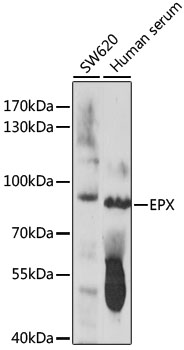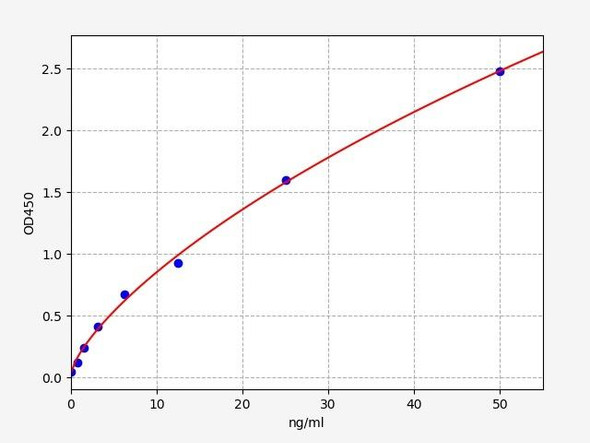Signal Transduction Antibodies 2
Anti-EPX Antibody (CAB16450)
- SKU:
- CAB16450
- Product Type:
- Antibody
- Reactivity:
- Human
- Host Species:
- Rabbit
- Isotype:
- IgG
- Antibody Type:
- Polyclonal Antibody
- Research Area:
- Signal Transduction
Description
| Antibody Name: | Anti-EPX Antibody |
| Antibody SKU: | CAB16450 |
| Antibody Size: | 20uL, 50uL, 100uL |
| Application: | WB |
| Reactivity: | Human |
| Host Species: | Rabbit |
| Immunogen: | A synthetic peptide corresponding to a sequence within amino acids 400-500 of human EPX (NP_000493.1). |
| Application: | WB |
| Recommended Dilution: | WB 1:500 - 1:2000 |
| Reactivity: | Human |
| Positive Samples: | SW620, human serum |
| Immunogen: | A synthetic peptide corresponding to a sequence within amino acids 400-500 of human EPX (NP_000493.1). |
| Purification Method: | Affinity purification |
| Storage Buffer: | Store at -20'C. Avoid freeze / thaw cycles. Buffer: PBS with 0.02% sodium azide, 50% glycerol, pH7.3. |
| Isotype: | IgG |
| Sequence: | TELR RLNP RWNG DKLY NEAR KIMG AMVQ IITY RDFL PLVL GKAR ARRT LGHY RGYC SNVD PRVA NVFT LAFR FGHT MLQP FMFR LDSQ YRAS APNS HVPL S |
| Gene ID: | 8288 |
| Uniprot: | P11678 |
| Cellular Location: | Cytoplasmic granule |
| Calculated MW: | 81kDa |
| Observed MW: | 81kDa |
| Synonyms: | EPX, EPO, EPP, EPX-PEN, EPXD |
| Background: | This gene is a member of the peroxidase gene family and is expressed in eosinophils. The encoded preproprotein is proteolytically processed into covalently attached heavy and light chains to form the mature enzyme, which functions as an oxidant. The enzyme is released at sites of parasitic infection or allergen stimulation to mediate lysis of protozoa or parasitic worms. The gene is found in a gene cluster with other peroxidase genes on chromosome 17. Mutations in this gene result in eosinophil peroxidase deficiency. |
| UniProt Protein Function: | EPX: Mediates tyrosine nitration of secondary granule proteins in mature resting eosinophils. Shows significant inhibitory activity towards Mycobacterium tuberculosis H37Rv by inducing bacterial fragmentation and lysis. Defects in EPX are the cause of eosinophil peroxidase deficiency (EPD). EPD is an autosomal recessive defect where anomalous eosinophils are characterized by nuclear hypersegmentation, hypogranulation, and negative peroxidase and phospholipid staining. Belongs to the peroxidase family. XPO subfamily. |
| UniProt Protein Details: | Protein type:Oxidoreductase; EC 1.11.1.7 Chromosomal Location of Human Ortholog: 17q23.1 Molecular Function:peroxidase activity; metal ion binding; heme binding Biological Process: positive regulation of interleukin-4 production; negative regulation of interleukin-10 production; hydrogen peroxide catabolic process; negative regulation of interleukin-5 production; response to oxidative stress; defense response to nematode Disease: Eosinophil Peroxidase Deficiency |
| UniProt Code: | P11678 |
| NCBI GenInfo Identifier: | 4503595 |
| NCBI Gene ID: | 8288 |
| NCBI Accession: | |
| UniProt Secondary Accession: | P11678,Q4TVP3, |
| Molecular Weight: | |
| NCBI Full Name: | eosinophil peroxidase preproprotein |
| NCBI Synonym Full Names: | eosinophil peroxidase |
| NCBI Official Symbol: | EPX |
| NCBI Official Synonym Symbols: | EPO; EPP; EPXD; EPX-PEN |
| NCBI Protein Information: | eosinophil peroxidase |
| UniProt Protein Name: | Eosinophil peroxidase |
| Protein Family: | Eosinophil peroxidase |
| UniProt Gene Name: | EPX |
| UniProt Entry Name: | PERE_HUMAN |
View AllClose







